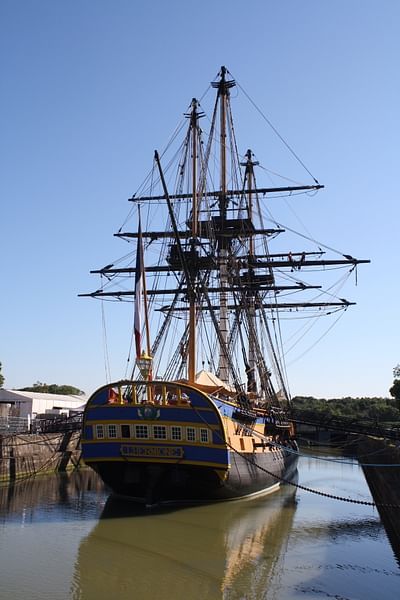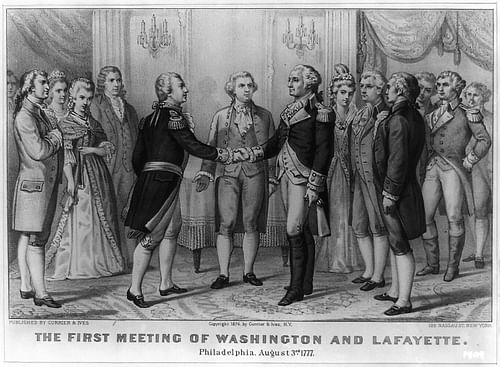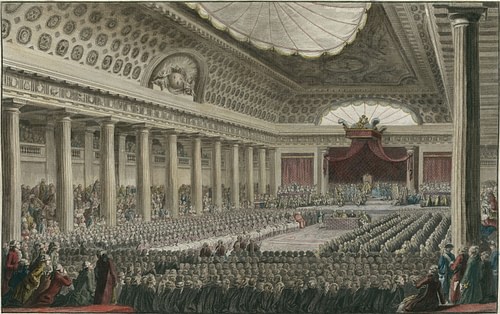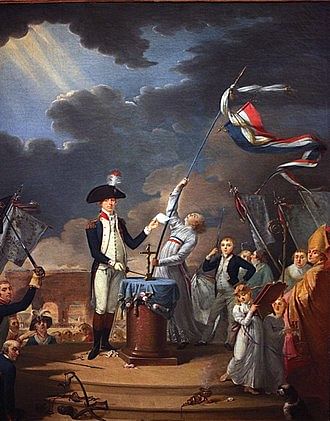Marie Joseph Motier Marquis De La Fayette
Marie-Joseph Paul Yves Roch Gilbert du Motier, Marquis de La Fayette (l. 1757-1834), more commonly known in the United States as just Lafayette, was a French aristocrat, military officeholder, and pol. He was a major figure in both the American and French revolutions, helping to shape the destiny of both countries.
At the historic period of 18, he left French republic against explicit orders from the king to fight the British in the American State of war of Independence (1775-1783), where he chop-chop rose through the ranks to become one of George Washington'due south most trusted generals, commanding American forces during meaning campaigns such as Yorktown.
After returning to France, his zeal for republican ideals led him to get an important figure in both the French Revolution (1789-1799) and the July Revolution of 1830. He was instrumental in drafting the Declaration of the Rights of Human and of the Denizen in French republic, modeled on the U.S. Declaration of Independence, and helped steer France through ane of its about difficult periods. His interest in the revolutions of both the U.s.a. and France earned him the nickname "the Hero of the Two Worlds" (Le Héros des Deux Mondes).
Early Life
Lafayette was built-in on 6 September 1757 at the Château de Chavaniac, an austere, fortress-like estate in Auvergne, near 500 km (300 mi) south of Paris. The rather militant blueprint of the family chateau perfectly reflected the La Fayette family unit'due south military tradition, stretching back to the founding of the family unit by one Pons Motier, who was granted the fiefdom of Villa Faya around 1000. In 1250, a La Fayette served nether Louis Ix of France (r. 1226-1270) during the 6th Crusade and allegedly seized the Crown of Thorns. In 1428, Gilbert 3 de La Fayette, align of French republic, rode alongside Joan of Arc at the legendary Siege of Orleans. The most recent warrior prior to Lafayette'southward own fourth dimension was his father, who, at 27, served equally a grenadier colonel during the Vii Years' War, where he was killed past a British cannonade at the Boxing of Minden in 1759. The elderberry Lafayette'southward death left his son with the championship of marquis, at the age of two.
When Lafayette was enrolled in the Collège du Plessis, he became exposed to enlightenment ideas that only increased his passion for liberty.
Listening to such tales of glory, Lafayette naturally began to yearn for adventures of his own. As he would later describe of his childhood, he fancied himself something of a Vercingetorix, "defending the mountains of Auvergne", and would afterwards write of his childhood that he remembered aught more than than his "fervor for tales of glory and my plans to travel the world in quest of fame" (Unger, 7). He also developed another quality that would prove no less important in his career: a love for the commoners and liberty. From a young historic period, he cultivated a fondness for the peasants around Auvergne, who were devoted to his family since Lafayette'south aunt allowed them to chase in their forest and gifted them the surplus foodstuffs that her ain family did not need. When Lafayette was enrolled in the prestigious military schoolhouse the Collège du Plessis, he became exposed to enlightenment ideas that simply increased his passion for liberty.
In 1770, while Lafayette was in Paris as a cadet in the prestigious Blackness Musketeers, his female parent and grandmother died within weeks of one another, leaving him an annual income of 120,000 livres. This newfound wealth, equally well as his high status equally a Black Musketeer cadet who took riding practice aslope King Louis XV of France'south ain grandsons, made him one of the most eligible bachelors in Paris. For these reasons, he defenseless the centre of the duc d'Ayen, an influential noble from the famous de Noailles family. D'Ayen believed that 14-year-erstwhile Lafayette would be an platonic match for his 12-year-old girl Adrienne and began making marriage arrangements, taking a personal involvement in continuing Lafayette's pedagogy. In 1774, they were officially wed, and the marriage contract was signed both past Louis XV (r. 1715-1774) and the Dauphin, who would be crowned King Louis 16 of France (r. 1774-1792) less than a calendar month later. Looking to advance his son-in-law'south career, d'Ayen enlisted Lafayette in the elite Noailles Dragoons.

Hermione Frigate
Revolution in America
Afterwards Corking United kingdom of great britain and northern ireland's 13 American colonies asserted their independence, the fledgling United States knew information technology needed foreign support if it hoped to win a state of war against one of the world's foremost powers. As role of their efforts, American diplomats in Paris looked to enlist French officers to accept commissions in the Continental Army in return for training American soldiers. Lafayette jumped at the gamble, just the British presently uncovered the plan and threatened to consider French republic in a land of war, should the officers be immune to depart. The government of Louis Xvi issued a decree forbidding any French officers from adventuring in the Americas, on penalty of imprisonment. Lafayette, whose condition as a Musketeer and close ties to the French court at Versailles marked him of special interest, was explicitly mentioned by name in the king's decree.
Lafayette was sent to London, where he met with important British officials, including King George III (r. 1760-1820). He still intended to go to America, wishing to "right the wrongs of the last war, to fight the English and to fly to the assistance of the Americans" (Auricchio, 31), and the nineteen-year-old marquis slipped out of France aboard the ship Victoire, without a give-and-take to his family to avoid arousing suspicion. After an arduous cross-Atlantic voyage, he set foot in Charleston in June 1777 and made his way to Philadelphia to receive his promised committee. Congress was reluctant, however, every bit they had seen an influx of strange officers beyond expectation, many of whom lacked real experience and spoke piffling English. Although Lafayette himself had all the same to see a battle, he managed to win Congress over with his enthusiasm and his status as a Freemason, and he was given the rank of major full general.

The First Meeting of Washington and Lafayette
Information technology was in Philadelphia that Lafayette get-go met George Washington (fifty. 1732-1799), commander-in-master of the Continental Ground forces. Lafayette was immediately taken by Washington's demeanor, seeing in the Virginian aristocrat the virtue of the Roman Republican heroes he admired. When Washington first introduced the young Frenchman to the American army'due south camp, the general expressed embarrassment at how his own ragged force must look to an officer straight from the French army. Lafayette responded: "I came here to learn, not to teach" (Unger, 41). The two men quickly formed a bail, and Lafayette found in Washington a lifelong friend and begetter figure.
Lafayette had his outset sense of taste of combat on 11 September 1777 at the Battle of Brandywine Creek, where he was wounded in the left dogie while trying to rally fleeing American soldiers. He spent less than ii months recovering, before returning to the field, victoriously leading 300 soldiers against a superior Hessian strength at Gloucester. He remained fiercely loyal to Washington, staying by the general's side at Valley Forge until ordered to mount an invasion of Canada, a command he refused to accept unless he acted beneath Washington's authority. Although the planned invasion never materialized, in the winter of 1777 Lafayette managed to meet with the Half-dozen Nations of the Iroquois in upstate New York, going so far as to win the Oneidas over to the American crusade. The Oneidas were so impressed with the young Frenchman that they bestowed upon him the proper noun Kayewla, or "fearsome horseman".
Equally the American Revolutionary War wore on, Lafayette connected to serve in increasingly of import roles, commanding divisions at significant battles such as at Monmouth Court House and Newport. He became a pop effigy in the United states, condign fast friends with many soldiers, members of Congress, and Founding Fathers. Back in France, tales of his heroism in America were widespread, and he was raised to somewhat of a celebrity condition, particularly later France officially joined the state of war on the side of the Americans in 1778.
Spending the year 1779 back in French republic, Lafayette helped organize the French forces that would be sent to America, while also planning a daring invasion of United kingdom of great britain and northern ireland itself, which ultimately never occurred. In 1781, Lafayette was leading an regular army in Virginia, engaged in a game of cat and mouse with a British regular army led past Lord Cornwallis (l. 1738-1805). Lafayette trapped Cornwallis in the trading port of Yorktown and managed to concord him at that place until Washington could arrive by land while a French navy blockaded the port from the sea. Cornwallis surrendered on 19 Oct, and this was one of the last significant conflicts of the war. The Treaty of Paris of 1783 saw the Usa' independence, and Lafayette returned to France.
Revolution in France
Lafayette worked to establish stronger Franco-American ties, advocated for the rights of French Protestants, & argued for the abolition of slavery.
Later existence reunited with his wife and iii children back in Auvergne, Lafayette worked to establish stronger Franco-American ties, advocated for the rights of French Protestants, and argued for the abolition of slavery. In the meantime, the late 1780s found France in a steadily increasing country of chaos, facing a fiscal crisis, large-scale unemployment, and widespread famine. National unrest connected to worsen until 1789 when Louis XVI was forced to convene the Estates Full general for the starting time time in 175 years.
The Estates General was a legislative and consultative assembly, comprised of the three different estates, or classes, of French subjects: the clergy, the nobility, and the commoners. Each manor received only 1 vote, and then the kickoff two estates, which represented merely 10 percentage of the population and often voted together, could always outvote the tertiary manor, which represented the other 90 percent. To counter this, Lafayette proposed convening a national assembly instead, where each individual would accept a single vote, but this was initially shot down.
The Estates Full general met in Versailles on 5 May 1789, with Lafayette elected as a representative for the second manor. Although the original topic of word was supposed to exist taxation, the chat quickly dissolved into arguments regarding the Estates' compositions, specifically most the imbalance of power. After more a calendar month's deliberation, with royalists failing to bring the conversation dorsum to taxes, the tertiary manor, with some support from private members from the other estates, declared themselves a National Assembly.

The Opening of the Estates General
They invited the other estates to join them but declared their intent to conduct national policy with or without them. The enraged royalists responded by using soldiers to bar the members of the National Assembly, including Lafayette, from entering Versailles, prompting the members to swear an oath in the majestic lawn tennis court to non disband until a constitution could be established.
Seeing this every bit an opportunity to bring his beloved American ethics to his birth country, Lafayette met with his friend Thomas Jefferson (l. 1743-1826), and together they produced the kickoff draft of what would become the Proclamation of the Rights of Man and Citizen. The declaration proclaimed the natural rights familiar to Enlightenment ideals including the thought that men are born free and equal, and that all men have the inalienable rights to liberty, holding, safety and resistance to oppression. However, even every bit Lafayette was finishing the draft, things continued to escalate in Paris. On xiv July, the very day the National Assembly met to consider the declaration every bit a preamble to their new constitution, the Bastille was stormed.
The next day, facing chaos and disorder in the streets of Paris, the National Assembly appointed Lafayette to the control of the newly formed National Guard, charging him with keeping society in the city. Lafayette took his new role seriously, training the men under his command to the best of his ability. He outfitted them with cockades that combined the ruby-red and blueish colors of the revolution with Bourbon white, hoping to demonstrate the Baby-sit's commitment to both the people and the crown. This symbol would afterwards get the tricolor of France.
As he croaky down on street crime, he simultaneously lobbied the Associates to reorganize the regime into a constitutional monarchy, which would allow Louis XVI to retain the throne, while likewise introducing republican principles to France. However, this middle basis made Lafayette many enemies; royalists viewed him as a dangerous revolutionary trying to overthrow the monarchy, while radicals like the Jacobins felt he was not going far enough to assistance the people. To Lafayette, keeping law and order was the nigh important affair, and in 1790, he helped organize the Fête de la Fédération, a massive holiday festival held in award of the Revolution. On the Champ de Mars, in forepart of 350,000 Parisians, Lafayette led the crowd in an adjuration swearing allegiance to the nation, the police force, and the king. This was perhaps the acme of Lafayette'southward popularity, a time when his grip over the city led him to write to a friend, "I reign in Paris" (Auricchio, 193).

Oath of La Fayette at the Fête de la Fédération, 14 July 1790
On 20 June 1791, Louis XVI and his family unit would escape from their abode imprisonment at Tuileries. Although they were defenseless by the National Baby-sit and escorted back by Lafayette himself five days after, the upshot made many suspicious of the marquis, since information technology was nether the sentinel of Lafayette'southward men that the royal family unit escaped. Jacobin leader Maximilien Robespierre (fifty. 1758-1794) went so far as to proper name him a traitor to the people. Lafayette'southward reputation worsened further on 17 July, when soldiers under his command opened burn down at an anti-monarchy sit-in at the Champ de Mars, leaving several French citizens dead. Post-obit the massacre, a mob attacked his dwelling and attempted to harm Adrienne, who managed to escape. Lafayette resigned from his command in Oct, subsequently a constitution had been ratified.
By 1792, revolutionary fervor had swept France into state of war with Republic of austria and Prussia. Lafayette was given control of one of the new armies raised, but he soon became wary of his new position. Jacobin power had been growing, and many of Revolutionary France'south new soldiers were untrained Jacobins who hated their superior officers. Lafayette's mistrust of the Jacobins led to Robespierre to again call him a traitor in front of a mob, which burned him in effigy. Lafayette fled to the Austrian Netherlands, hoping to gain passage to the The states from there. However, he was intercepted by Austrian soldiers and placed under arrest. The monarchs of Austria and Prussia viewed him as a unsafe revolutionary, who should be imprisoned until a restored king of France could pass judgment, and he was therefore transferred to the prison of Olmütz, where he would spend the remainder of the French Revolution. In September 1797, subsequently 5 years of imprisonment, his release was finally negotiated by Napoleon Bonaparte (l. 1769-1821), and he eventually returned to France.
Afterward Years
Following his release, Lafayette spent the next few decades out of the public eye, in his home of La Grange. Although his son, George Washington Lafayette, briefly served in Napoleon's army, Lafayette himself disapproved of the emperor and played little office in national affairs for the duration of Napoleon'due south reign too equally the Bourbon Restoration that followed. In 1824, Lafayette was invited by President James Monroe (fifty. 1758-1831) to embark on a 1000 bout of the The states to commemorate the country's 50th anniversary. He accepted, visiting each of the 24 states, and was received past great fanfare and adoration wherever he went.
When he returned to France, Paris was again in unrest. The new king, Charles X (r. 1824-1830), intended to restore an absolute monarchy and had placed many restrictions on civil liberties. In July 1830, a new revolution swept through Paris, with the 73-year-old Lafayette appointed as commander of a restored National Baby-sit. Upon Charles' abdication, Lafayette threw his weight behind Louis-Philippe (r. 1830-1848) as the next rex. Standing upon a balcony, Lafayette presented the new rex with a tricolor flag, charging him to uphold the constitution.
Lafayette died at age 76 on xx May 1834. He was buried beside his wife at the Picpus Cemetery, with soil from Bunker Hill sprinkled over his grave.
This article has been reviewed for accuracy, reliability and adherence to academic standards prior to publication.
Marie Joseph Motier Marquis De La Fayette
Posted by: blackwellmorgilizeed77.blogspot.com